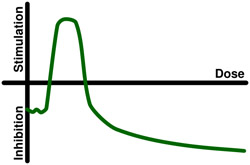 April 12, 2011
April 12, 2011
Hormesis is an example of non-linear thinking clashing with linear. Hormesis, in general, is that the effects of a substance at high and low concentrations may be very different. Vitamins like A, C, and D and several metallic elements are well known examples. Essential to life in minute concentrations, they are fatal in high doses. People have even died from drinking too much water too fast, diluting their sodium and other electrolytes too much for the body’s system to rebalance. Hormesis effects frequently surprise people, and many are controversial.
The figure is a standard graph used to depict the general effect.
Japan’s stricken nuclear plants have revived an old controversy: radiation hormesis. Limited evidence suggests that radiation doses slightly above global background may actually benefit health. Of course, higher and higher doses sicken people and finally kill them. But thinking linearly, we assume that if radiation is fatal at high doses, it must be harmful at any level. But if this is untrue, at what dosage level does radiation transition from benefit to detriment? Not only are big segments of the Japanese public being exposed beyond standard, workers at Japan’s nuclear plants were routinely over-exposed before the earthquake. Was this necessarily bad, and if so how bad was it?
Hormesis fits into Compression Thinking because it exemplifies non-linear thinking, which clashes with linear in many contexts. Linearity is the easy assumption when understanding of a process or its potential consequences is limited. For example, we may assume that if a little fertilizer promotes plant growth, a lot more should accelerate it. In addition, farmers are apt to apply more nitrogen fertilizer than soil and plants can absorb if they don’t know the consequences elsewhere: that excess washing off fields forms algae in streams and rivers and finally “dead zones” at the mouths of rivers.
Reality is that few processes are truly linear, whether they have hormesis effects or not, but public misunderstanding is hard to counteract. Because of this, toxicologists rarely explain hormesis. They duck its issues by saying that, “the dose makes the poison.” Misunderstanding goes two ways: belief that if exposure to a large amount of some chemical is harmful, exposure to small amounts must be also. And in reverse, if a small amount is beneficial, a lot more must surely be better.
Understanding is affected by psychology and emotion. We learn by testing limits, but if emotion overrides intellect, we test limits even when we know better. For example, a little alcohol may benefit health, while excess consumption, short-term or long-term, is obviously harmful. However, otherwise sane people compete to drink each other under the table, and once in a while a loser dies. Likewise, some of us get a big rush from defying death, like driving as fast as possible or engaging in extreme sports. The dangers of too little or too much exercise are often used to illustrate hormesis with a “mid-range” optimum.
In finance, linear thinking is common, and it may be influenced by emotion. For instance, if we assume that a company can grow both top and bottom lines indefinitely, its stock value should rise indefinitely. Thinking that organizational growth is linear is also common; it lets us dream that a highly effective organization can scale up indefinitely without losing effectiveness.
That’s why Compression Thinking promotes understanding total systems by looking at physical reality, including elements not identified by any cost figures. Tools that help are total input-output, mass-energy balance, and trying to foresee the complete life cycles of products and processes. These are not enough. They don’t factor in the human elements, and we don’t have unlimited time, but if we attempt to foresee future consequences, we should have far fewer cases of short-term (linear) decisions leading to unforeseen messes.
Such thinking is more likely to detect hormesis effects, among many others. In addition, leaders that think this way see the purpose of an organization as creating long-term quality outcomes before immediate profits. That’s a non-linear value system, leading to a different concept of what an organization and its people are meant to do. It contrasts mightily with the concept of a company as a linear machine to funnel ever-growing money returns to ownership.
